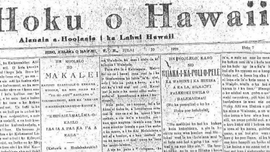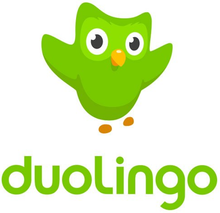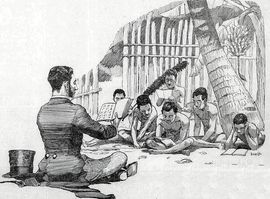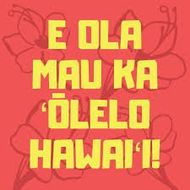HAWAIIAN LANGUAGE
STUDY INFORMATION
STUDY INFORMATION
Hawaiian Language Learning Resources
This is our collection of learning resources to aid in your study of the Hawaiian language. Here you'll find links to various sites that will help in your language journey and also our own Learning Library with explanations of grammatical forms and word usage, shared from our personal learning experiences. We are students of ʻŌlelo Hawaii just like you are, and your comments, corrections, and suggestions are welcomed. Please visit the
ABOUT page to learn more about our background and who we are.
The Hawaiian Language Reference Grammar
Iokepa and Anita Bardwell were two of five authors who compiled what may be the most complete Hawaiian grammar student reference to be found anywhere. Over the course of 2019, the team cross-referenced and consolidated, effectively, all available grammar texts and references available today. The book also includes organized notes and handouts from 1st through 4th year Hawaiian studies at the University of Hawaii.
Hosted Hawaiian Language Learning Meetups
In 2018, the Duolingo language learning application made a Hawaiian language course available with the help of Kamehameha Schools. In 2019, Iokepa and Anita Bardwell became a volunteer Duolingo hosts on Maui led weekly Duolingo for over two years. In January, 2023, Duolingo retired their class program and hosted events were no longer offered.
The Hui ʻŌlelo Hawaiʻi is continuing, hosted and sponsored by Iokepa and Anita. For more information, see the Zoom Meetups page.
Anita and Iokepaʻs Journey Into The Hawaiian Language Revitalization Effort
After traveling to the Hawaiian islands as annual visitors for over 10 years, Joe (Iokepa) and Anita Bardwell knew that their hearts felt at home on Maui. They first lived in Haiʻku and then moved to Kahului, where they live now. Committed to the land and the culture, they began their study of ʻŌlelo Hawaii in 2013. They've seen, first-hand, the impacts of American and European colonization and the illegal occupation of the Kingdom of Hawaii by American armed forces and the American government. Issues that have included water rights for farmers, disruption of burial sites, land grants for native Hawaiians, and proposals to build the Thirty Meter Telescope on Mauna Kea have made it clear that every person's individual effort is needed to support the Kingdom of Hawaii.
Joe (Iokepa) and Anita Bardwell have been students of the Hawaiian language since 2013, studying at the University of Hawaii, and with community classes at Punana Leo and Kaiapuni Pāʻia. One of their key goals is to be certified as Hawaiian language immersion teachers by the State Department of Education. They are language coaches, leading a group of learners in weekly Duolingo Zoom meetups and they continue to be actively involved in the development and revisions of the Hawaiian Reference Grammar book.
As educators, Iokepa and Anita found a natural fit in the language revitalization movement that began in the 1970ʻs and grows stronger every year.
A Brief History Of The Hawaiian Language
Prior to the 1778 arrival of Captain Cook to the Hawaiian islands, ʻŌlelo Hawaii (the Hawaiian language) was an oral language. It was after missionaries arrived in Hawaii in 1820 that a written form of the language was created (so that the bible could be translated and read by the people.) By 1834 itʻs estimated that over 90% of all Hawaiians were literate and, between 1834 and 1948 over 100 different Hawaiian language newspapers were published.
Although the Hawaiian language is one of the oldest known languages in the world, it came close to extinction following the annexation of Hawaii as a territory of the United States in 1898. As part of the efforts to colonize the islands and alter the Hawaiian peopleʻs word view, the language was officially banned from use in schools and government. People were taught that only by using English could they succeed in the emerging modern world.
The annexation was opposed by most native Hawaiians however, a group of American businessmen pushed the issue through the United States Congress. These actions, and the subsequent illegal overthrow of the Kingdom of Hawaii, were acknowledged in the 1993 Apology Resolution, passed by the US Congress, in which the United States formally apologized to the Kingdom of Hawaii for their illegal actions.
The language was not banned in general and people still spoke Hawaiian at home. In addition, Hawaiian language newspapers continued to be published. Nonetheless, an entire generation grew up in a predominantly English-speaking world. By the mid-1900ʻs, only oldest Hawaiians remained as fluent speakers. The language was approaching extinction.
Legal constraints against using the Hawaiian language persisted until 1986. It was the renaissance of Hawaiian culture and politics in the 1970ʻs that brought language revitalization into focus. By 1978 the Hawaiian language was reestablished as an offical state language and, in 1983, the Aha Punana Leo organization was formed to revive the language through the creation of immersion pre-schools. By 2002, the University of Hawaii awarded the first masterʻs degree completed entirely in the Hawaiian language.
In a 2016 Hawaii state report, there were over 18,000 Hawaiian language speakers making it the fifth most widely spoken language in Hawaii.
How Maui Communications Networks LLC
Supports Language Revitalization
Communication includes language. While Maui Communications Networks LLC was originally conceived as a technology consulting company it became evident that the LLC structure could easily be expanded to include outreach and revenue management for Hawaiian language revitalization efforts.
Under the umbrella of Maui Communications Networks LLC, Iokepa and Anita continue to give back to the illegally occupied Kingdom of Hawaii in every way possible.







